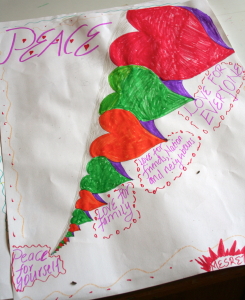In WISH (Women of Integrity, Strength, and Hope) class this term, third year Daraja students (11th grade) are learning all about conflict resolution and peace building. Piggybacking Alice Nderitu’s peace building talk during Term Two, the lessons are full of exciting ways to brainstorm the development of peace throughout the world, but more specifically, in Daraja students’ home communities.
Following the attack on the Westgate Mall in Kenya’s capitol, Nairobi, Daraja students were eager to make sense of the violence and have discussions about how peace building strategies can intervene in conflicts such as these and help prevent them in the future.
In the lesson prior, third year students were asked to envision an ideal world or ideal Kenya for the year 2030. The objective of this exercise was to create an end for which peace building would serve as the means. After the attack, the girls were ready to continue with positive lessons encouraging them to think about peace and potential rather than dwelling on negative realities such as violence.
To explain the exercise, volunteer, Jane, outlined a “violence tree,” where the causes of violence served as the root system, and the manifestations and different types of violence served as the branches. Because of the harm that this tree creates in the world, the tree was unhealthy and bore no leaves, flowers, or fruits. Next, the girls were each given a large sheet of paper and markers to create their own personal “peace tree.” After individually reflecting and devising “roots” and “branches” of peace, the girls put markers to paper to illustrate their ideas.
Some girls chose to illustrate peace using the tree metaphor, while others exhibited their creativity and illustrated peace in other ways. Mesret drew a series of hearts, growing in size.
Despite running out of time, girls agreed to extend their class into their free time based on their excitement to present and share their ideas. When presenting, Mesret explained her hearts by saying, “The smallest heart represents the love and peace that you must have in yourself in order for the rest of the world to see peace. As more and more people accept that love for themselves, peace grows into everyone having love for everyone else.”
This exercise proved to be helpful in response to the attack in Nairobi, and also relevantly supplemented the WISH curriculum. We are thankful that the entire Daraja community including students, staff, and their families are all safe and accounted for after the attack and out hearts go out to the victims and their loved ones.


Leave A Comment